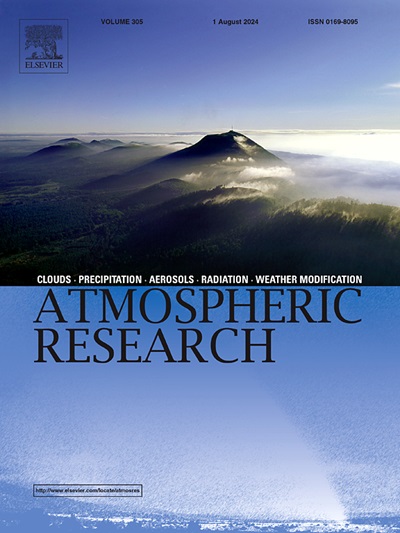Data assimilation of weather radar reflectivity with a blending hydrometer retrieval scheme for two convective storms in East China
IF 4.5
2区 地球科学
Q1 METEOROLOGY & ATMOSPHERIC SCIENCES
引用次数: 0
Abstract
Based on the Weather Research and Forecasting (WRF) model and its data assimilation (DA) system, different hydrometeor retrieval schemes are explored in the indirect assimilation of radar reflectivity for two convective storm cases occurred in Jiangsu and Anhui. In indirect radar reflectivity data assimilation, two frequently-used hydrometeor retrieval methods exist: background-temperature-dependent (BTD) and background-hydrometeors-dependent (BHD) schemes. The BTD method empirically assigns contribution ratio of hydrometeors to the total equivalent reflectivity across different background temperature thresholds. The BHD scheme derives each type of hydrometeor based on proportions estimated from the background for different heights and reflectivity intervals. In this study, an adaptive blending scheme is developed to integrate the BTD and BHD methods. This approach aims to mitigate errors associated with empirical temperature relationships and the fixed proportion of the weights for snow and graupel in the BTD scheme and with uncertainties inherent in the hydrometers from the background in the BHB scheme. The standard deviations of the hydrometeor mixing ratios from each scheme based on surrounding 25 grid points are utilized to derive weights that dynamically blend the contributions of the two methods. The results from the Exp_hydro experiment using the blending scheme demonstrate that this approach adaptively adjusts the hydrometeor weights of the other two retrieval schemes in response to background changes during the DA cycle. Consequently, the analysis achieves hydrometeor mixing ratios that are more consistent with the background conditions. Furthermore, the forecasts from the Exp_hydro experiment demonstrate that blending scheme improves the accuracy of the reflectivity echo structure and surface wind in the short term for the Jiangsu case. For the Anhui case, the FSSs for precipitation and reflectivity further demonstrate the measurable improvements of the blending hydrometeor retrieval scheme.
求助全文
约1分钟内获得全文
求助全文
来源期刊

Atmospheric Research
地学-气象与大气科学
CiteScore
9.40
自引率
10.90%
发文量
460
审稿时长
47 days
期刊介绍:
The journal publishes scientific papers (research papers, review articles, letters and notes) dealing with the part of the atmosphere where meteorological events occur. Attention is given to all processes extending from the earth surface to the tropopause, but special emphasis continues to be devoted to the physics of clouds, mesoscale meteorology and air pollution, i.e. atmospheric aerosols; microphysical processes; cloud dynamics and thermodynamics; numerical simulation, climatology, climate change and weather modification.
 求助内容:
求助内容: 应助结果提醒方式:
应助结果提醒方式:


